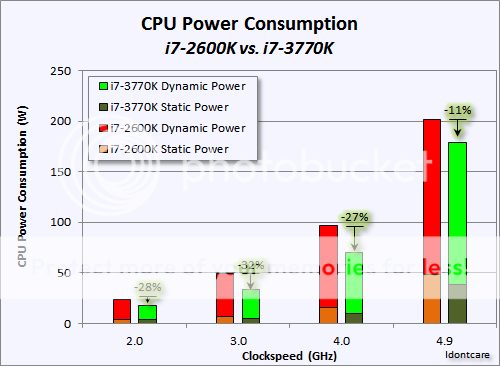If Intel claims 67% lower power...
If true then of course that changes everything...but I had read 14nm was 67% "of the power", not 67% "lower" power.
If 14nm is 0.67x the power of 22nm then power is only 33% lower, not 67% lower.
So the question is - is 14nm 0.67x that of 22nm, or is it 0.33x that of 22nm in terms of power consumption at comparable clockspeed and operating temperature?
22nm was only around 67% the power of 32nm, 0.67x under best conditions, so I'm not expecting miracles with 14nm where static leakage only continues to be more of an issue than it was at 22nm and 32nm.


So how do you think their R&D expenses, especially their node shrinks, play a role in all of this? They lost close to a billion dollars last quarter on their mobile division, some (or most) of it was seemingly towards R&D while the rest being contra revenue, & they're set to loose over a billion in each of the quarters following this last one!
So what I'm trying to say is that if it takes a fraction of the cost, for Intel, to make these chips, as compared to say Qualcomm or even Apple, then why don't they price these SoC accordingly as in cheaper than their desktop or server chips? I understand you might not be the right person to answer this or you may not be in a position to do so but do you, like many others, think that Intel can (ever) command a premium in the mobile arena especially when their (real) competition consists of Apple & Samsung atm D:
The contra-revenue strategy is a new tool in Intel's toolbox that is only possible because they are operating in a market segment with this business unit for which Intel is not an effective monopoly. That's not philosophical contemplation, that is straight from folks at Intel who deal with this situation.
The regulatory environment for the mobile group is delineated in a specific manner such that it can operate with contra-revenue.
The reason Intel doesn't simply discount the price of the chips is one of standard business practice - you never discount the price of something if you have any aspirations of going back to the higher price someday. Your customers simply won't stand for the price hike down the road.
So you keep the price where you want your customers to pay, it sets their expectations and yours in appropriate fashion, and then you subsidize the product development aspects on their side.
This lowers their risk of losses should the higher priced (to cover Intel's chip price) Intel-enabled product be a flop in the market. If it is a flop then its now loss to the OEM, they don't have an un-amortized R&D bill on their books (its on Intel's instead).
But should the product take-off, then presumably it does so while being positioned at the right price-point so as to be able cover the elevated chip costs associated with using Intel's chips while still leaving money on the table for the OEM to be OK with the new Intel-enabled product cannibalizing sales of their other product line-ups.
The BOM is up because it has Intel expensive chips inside, but it commands a price premium for the features and performance. So it would all work out.
It is an interesting strategy, one that Intel can afford financially and one that they can do in terms of the regulations because the products are not competing in a business environment where Intel is a duopoly or effective monopoly.
Another thing that I keep in mind when comparing processes is that TSMC's highest density processes are good to about 2 ghz while Intel makes 4 ghz chips. There are RAM chips more dense than either, but we discount those because they are too slow for logic. I think Intel should get credit for its power and frequency characteristics in addition to density when considering process advantage.
Idrive is the difference. Having a small numbered node label doesn't mean much if the underlying electrical parametrics are inferior.






